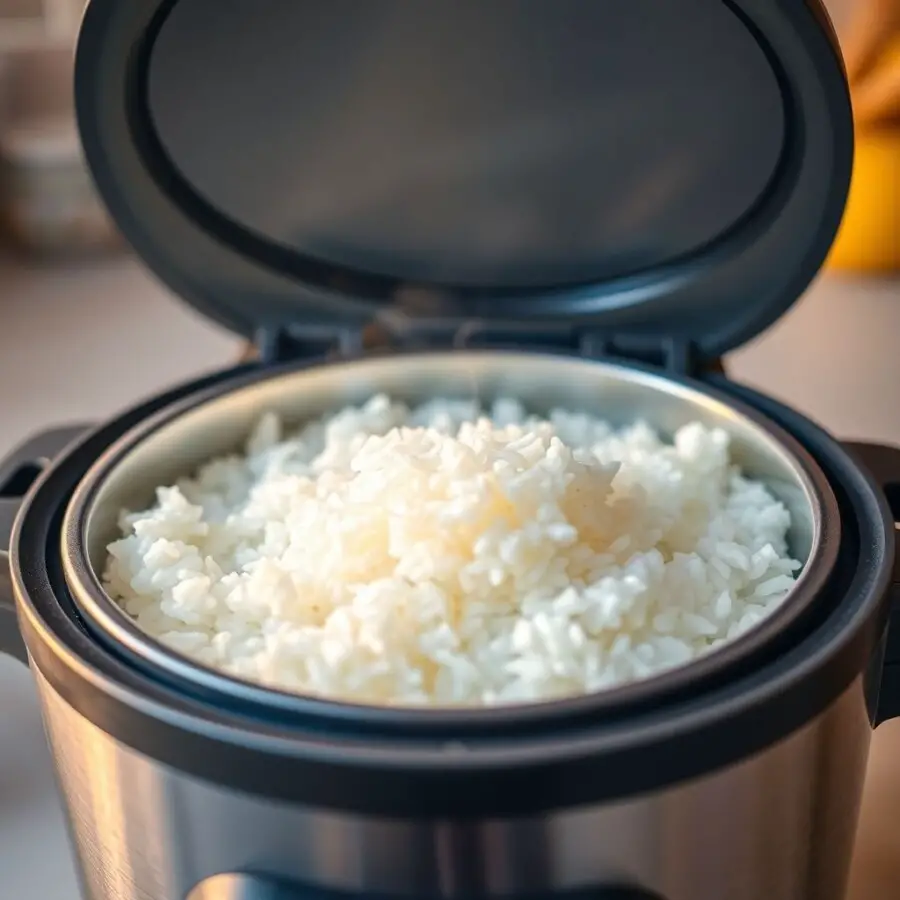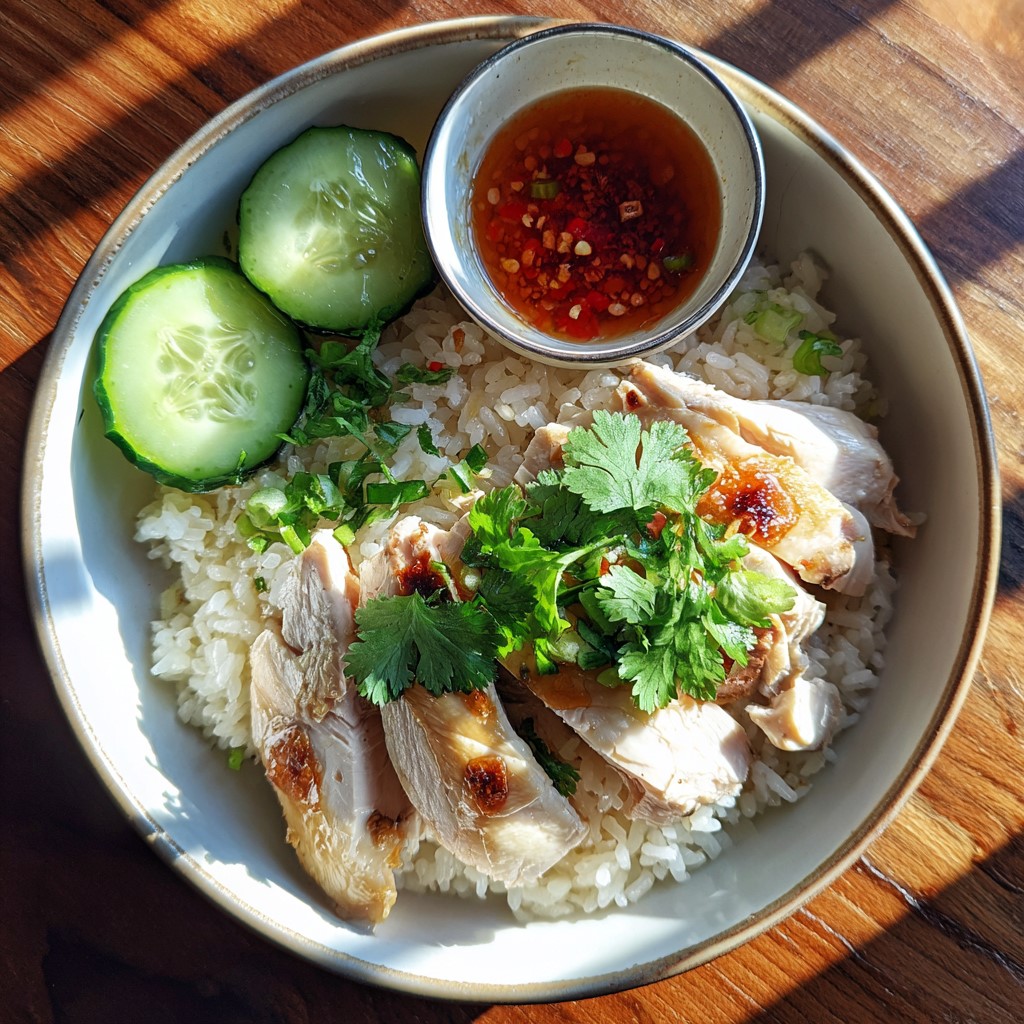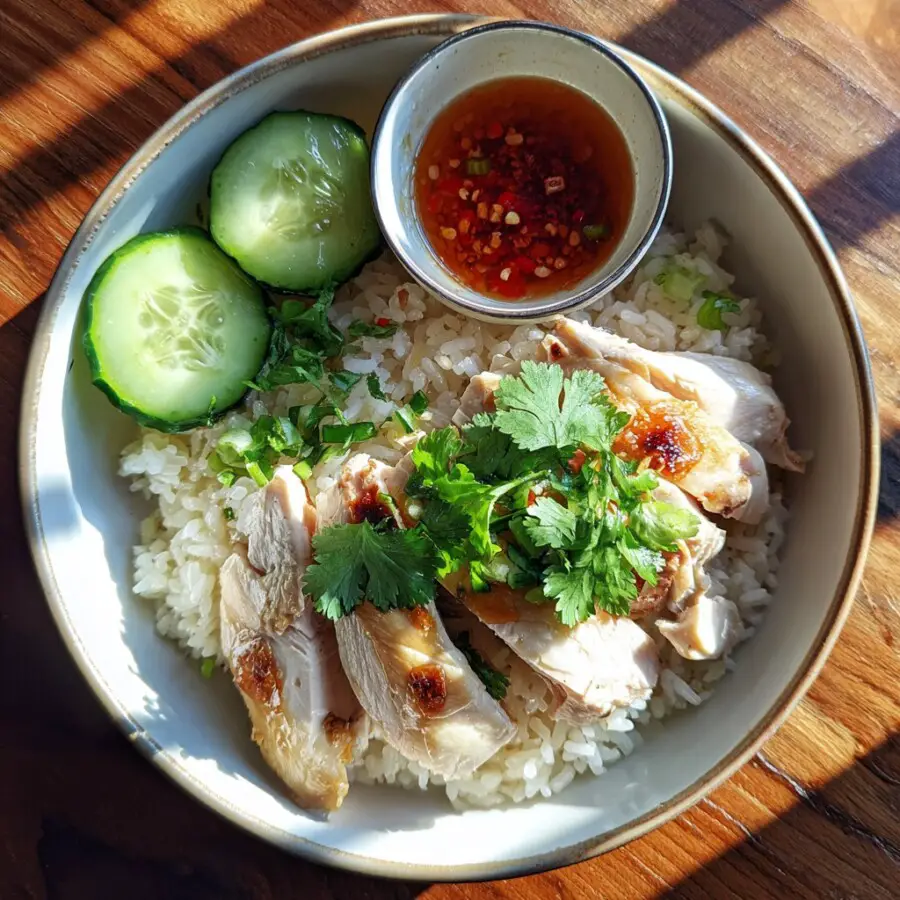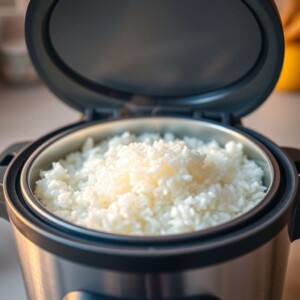So, you’ve got a rice cooker, huh? Most people think it’s just for, well, rice. But let me tell you, this little kitchen gadget is a real game-changer. It can do so much more than just cook perfect grains. We’re talking full meals, snacks, and even desserts. If you’re looking to simplify your cooking and try some new rice cooker recipes, you’re in the right place. Get ready to unlock the hidden potential of your trusty rice cooker
Table of contents
- Key Takeaways
- The All-Purpose Rice Cooker
- Effortless One-Pot Wonders
- Mastering Rice Cooker Chicken Rice
- Vibrant Rainbow Fried Rice
- Savory Stews and Braises
- Creative Rice Cooker Recipes
- Understanding Your Rice Cooker
- Healthy and Flavorful Meals
- Time-Saving Techniques
- Perfectly Cooked Grains
- Beyond the Basics: Advanced Uses
- So, What’s the Takeaway?
- Frequently Asked Questions
- What exactly is a rice cooker?
- Can I use my rice cooker to steam other foods?
- How do I cook basic rice in a rice cooker?
- Can rice cookers handle different kinds of grains, like brown rice or quinoa?
- Why is a rice cooker good for making one-pot meals?
- What does the ‘keep warm’ setting do?
- How do I clean my rice cooker?
- Are there any surprising things a rice cooker can do?
Key Takeaways
- Your rice cooker isn’t just for rice; it’s a versatile tool for steaming, baking, and making full meals.
- One-pot rice cooker meals save time and effort, perfect for busy weeknights.
- You can make impressive dishes like Hainanese Chicken Rice and “fried rice” with minimal fuss.
- Understanding how your rice cooker works helps you get the best results for various dishes.
- Using a rice cooker can lead to healthier, flavorful meals with less active cooking time and easy cleanup.
The All-Purpose Rice Cooker
Beyond Just Rice
Forget the name – a rice cooker is so much more than a one-trick pony! While it excels at cooking rice to perfection, its capabilities extend far beyond that. Think of it as a mini multi-cooker, ready to tackle a variety of dishes with minimal effort. You can cook other grains like quinoa, oats, or even polenta. Some models even have settings specifically for these grains, making it super easy to get perfect results every time. It’s a game changer for busy weeknights when you want a healthy and delicious meal without spending hours in the kitchen. The versatility is amazing.
Steaming Capabilities

Many rice cookers come equipped with a steaming basket, unlocking a whole new world of culinary possibilities. Steaming is a healthy way to cook vegetables, preserving their nutrients and vibrant colors. You can steam broccoli, carrots, asparagus, or any other vegetable you like. It’s also great for cooking fish or dumplings. The best part? You can often steam food while simultaneously cooking rice, making it a complete and balanced meal with minimal cleanup. This is especially useful for quick weeknight meals.
HERE IS YOUR OUTPUT
- Hainanese Chicken Rice (Rice Cooker Style)
- Easy One-Pot Hainanese Chicken Rice in the Rice Cooker
Ingredients:
For the Chicken & Rice:
- 1 ½ cups jasmine rice (rinsed until water runs clear)
- 2 boneless, skin-on chicken thighs or 2 bone-in chicken thighs
- 2 ½ cups low-sodium chicken broth (or water)
- 2 teaspoons sesame oil
- 1 tablespoon neutral oil (like canola or avocado oil)
- 3 garlic cloves (minced)
- 1 thumb-size piece of ginger (sliced thinly or minced)
- 2 green onions (cut into 2-inch pieces)
- ½ teaspoon salt
For the Chili Sauce (optional but recommended):
- 1 red chili or Thai chili (sliced)
- 1 garlic clove
- ½ teaspoon grated ginger
- 1 tablespoon lime juice
- 2 tablespoons chicken broth (from cooked rice)
- 1 teaspoon sugar
- Salt to taste
To Serve:
- Cucumber slices 🥒
- Fresh cilantro 🌿
- Soy sauce and extra sesame oil
Directions:
- Sauté Aromatics: Turn your rice cooker to “cook” or “sauté” mode (if it has one). Add 1 tbsp of neutral oil. Once hot, stir in the garlic and ginger and sauté for 1–2 minutes until fragrant but not browned.
- Add Rice: Stir in the rinsed jasmine rice to coat with oil and aromatics. Let it toast slightly for 1–2 minutes.
- Pour in Broth: Add the chicken broth, salt, and green onion pieces. Stir gently to distribute.
- Top with Chicken: Place the chicken thighs skin-side up directly over the rice. Drizzle 2 tsp sesame oil over the chicken.
- Cook: Close the rice cooker lid and set it to the regular white rice cooking cycle. Let it run its full course (about 30–40 minutes depending on your model).
- Rest: Once done, let it sit covered for 5–10 minutes.
- Slice and Serve: Remove the chicken, slice it, and serve it over the rice with cucumber, fresh herbs, and your chili sauce.
Chili Sauce:
Blend all ingredients in a mini food processor or crush with a mortar and pestle. Taste and adjust seasoning.
Prep Time: 10 minutes
Cook Time: 35 minutes
Total Time: 45 minutes
Serves: 2–3
Baking and More
Believe it or not, some rice cookers can even bake! While it might not replace your oven for elaborate cakes, it’s perfect for smaller treats like brownies or even a simple sponge cake. The non-stick inner pot acts as a baking dish, and the rice cooker’s gentle heat ensures even cooking. Plus, many models have a “keep warm” function, which can be used to proof dough or keep your baked goods warm until serving. It’s a fun and unexpected way to use your rice cooker, and it opens up a whole new range of recipe possibilities. Some rice cookers even play a tune when your cake is ready!
Using a rice cooker is about more than just convenience; it’s about simplifying your life. It’s about having a reliable appliance that can handle a variety of cooking tasks, freeing up your time and energy for other things. It’s about enjoying delicious, home-cooked meals without the stress and hassle of traditional cooking methods.
Here are some of the things you can cook in a rice cooker:
- Rice (of course!)
- Quinoa
- Oatmeal
- Steamed vegetables
- Dumplings
- Cakes
Effortless One-Pot Wonders
Minimal Prep, Maximum Flavor
Okay, let’s be real. Weeknights are chaotic. Who has time for complicated recipes? That’s where the rice cooker shines. It’s the ultimate shortcut to deliciousness. Think about it: dump everything in, press a button, and walk away. No babysitting, no constant stirring, just pure, unadulterated convenience. The beauty of these recipes lies in their simplicity. You can literally toss in your ingredients, set the timer, and come back to a fully cooked meal. It’s magic, I tell you!
Quick Weeknight Meals
Forget takeout! The rice cooker is your secret weapon for speedy suppers. We’re talking meals ready in under an hour, sometimes even less. Here’s a sample timeline:
- Prep: 5-10 minutes (chopping veggies, measuring ingredients)
- Cook Time: 25-40 minutes (depending on the recipe)
- Total Time: Under an hour!
Seriously, what’s not to love? Plus, cleanup is a breeze. One pot means minimal dishes. It’s a win-win situation.
Set It and Forget It
This is where the rice cooker truly excels. Imagine coming home after a long day to the aroma of a home-cooked meal, without having lifted a finger. The rice cooker handles everything. It’s like having a personal chef, only quieter and way more affordable. You can even use the keep warm function to ensure your meal is ready when you are.
I love that I can throw everything in the rice cooker before I leave for work, and dinner is ready when I get home. It’s a total game-changer for busy weeknights. No more excuses for ordering pizza!
Mastering Rice Cooker Chicken Rice
Hainanese Chicken Rice Made Easy
Hainanese chicken rice is a beloved dish, and making it in a rice cooker simplifies the entire process. Forget about juggling multiple pots on the stove! With a rice cooker, you can achieve that signature tender chicken and flavorful rice with minimal effort. It’s a game-changer for busy weeknights or when you just want a comforting meal without the fuss.
Succulent Chicken, Fragrant Rice
Achieving the perfect balance of flavors and textures is key to great chicken rice. Here’s how to do it in your rice cooker:
- Rice Preparation: Rinse the rice thoroughly until the water runs clear. This removes excess starch and helps prevent the rice from becoming too sticky.
- Aromatics are Key: Don’t skimp on the ginger, garlic, and scallions. These ingredients infuse both the chicken and rice with their distinctive fragrance.
- Chicken Placement: Place the chicken pieces directly on top of the rice. As the rice cooks, the chicken will steam, releasing its juices and flavoring the rice below.
- Cooking Time: Use the regular rice cooking setting on your rice cooker. The automated cycle ensures that both the chicken and rice are cooked to perfection.
Rice Cooker Hainanese Chicken Rice: One-Pot Asian Comfort
Equipment
- Rice Cooker
- Cutting Board
- Knife
- Bowl
- Ladle or Rice Paddle
Ingredients
For the Chicken Rice
- 1.5 cups jasmine rice rinsed until water runs clear
- 2 chicken thighs boneless or bone-in, skin-on preferred
- 2.5 cups chicken broth low-sodium
- 2 tsp sesame oil
- 1 tbsp neutral oil like canola or avocado
- 3 cloves garlic minced
- 1 thumb-size piece of ginger thinly sliced or minced
- 2 green onions cut into 2-inch pieces
- 0.5 tsp salt
Optional Toppings
- 1 cucumber thinly sliced
- 2 tbsp fresh cilantro chopped, for garnish
- 1 tbsp soy sauce for drizzling
- 1 lemon or lime cut into wedges
Instructions
- Turn your rice cooker to ‘cook’ or ‘sauté’ mode. Add neutral oil and sauté garlic and ginger for 1–2 minutes until fragrant.
- Stir in the rinsed rice and coat well with the aromatics. Lightly toast for 1–2 minutes.
- Add chicken broth, salt, and green onions. Stir gently, then place chicken thighs on top of the rice, skin-side up.
- Close the rice cooker lid and cook using the regular white rice setting (about 30–40 minutes depending on your model).
- Once done, let the rice rest for 5–10 minutes. Slice the chicken and serve over the rice with cucumber, cilantro, soy sauce, and citrus wedges.
Notes
Homemade Stock for Richer Flavor
While water works fine, using homemade chicken stock elevates the dish to another level. The stock infuses the rice with a deeper, richer flavor that’s simply irresistible. If you don’t have homemade stock on hand, store-bought low-sodium chicken broth is a good substitute. Just be sure to adjust the seasoning accordingly. For a richer flavor, consider using chicken rice stock instead of water.
Using chicken stock is a simple way to add depth and complexity to your chicken rice. It’s a small step that makes a big difference in the overall taste.
Here’s a simple guide for stock to rice ratios:
| Rice Type | Stock Ratio | Notes |
|---|---|---|
| White Rice | 1:1 | Adjust slightly based on your rice cooker. |
| Brown Rice | 1:1.5 | Brown rice needs more liquid. |
| Jasmine Rice | 1:1.25 | Jasmine rice is more fragrant and may need slightly less liquid. |
Vibrant Rainbow Fried Rice
Colorful and Nutritious
This rice cooker fried rice is a fantastic way to sneak in extra veggies! It’s not just about the taste; it’s about creating a meal that’s visually appealing and packed with nutrients. Think vibrant bell peppers, sweet corn, and tender peas. The more colors, the better! You can easily adapt this recipe to use whatever vegetables you have on hand, making it a great way to reduce food waste and ensure you’re getting a balanced meal. It’s a win-win!
No Frying Required
Forget standing over a hot stove! The beauty of this recipe is that it’s all done in the rice cooker. No need for oil splatters or constant stirring. This method also makes it a healthier option compared to traditional fried rice, as it uses significantly less oil. The rice cooker’s gentle cooking action ensures that the rice and vegetables are cooked evenly, resulting in a perfectly textured and flavorful dish. It’s a hands-off approach that delivers amazing results.
Versatile Vegetable Options
One of the best things about this recipe is its flexibility. Don’t be afraid to experiment with different vegetables! Some great options include:
- Broccoli florets
- Diced carrots
- Frozen peas
- Chopped bell peppers (red, yellow, orange)
- Corn kernels
Feel free to add other ingredients too, like cooked chicken, shrimp, or tofu, to boost the protein content. The possibilities are endless! Just make sure to chop the vegetables into small, bite-sized pieces so they cook evenly in the rice cooker. You can even use leftover roasted vegetables to add a smoky flavor to the dish. This cabbage roll casserole is another great way to use up leftover veggies.
This recipe is a blank canvas for your culinary creativity!
Savory Stews and Braises
Rice cookers aren’t just for rice! They’re surprisingly good at making stews and braises. Think of it as a mini slow cooker, perfect for those comforting, hearty dishes. The indirect heat is ideal for tenderizing meats and melding flavors together. It’s a great way to cook flavorful meals without a lot of fuss.
Chicken Wings in Cola
This might sound a little strange, but trust me, it’s delicious! Chicken wings simmered in cola become incredibly tender and have a sweet and savory glaze. It’s a popular dish in some parts of the world, and the rice cooker makes it super easy. Just toss the wings in with cola and some soy sauce, and let the rice cooker do its thing. You can add ginger and garlic for extra flavor. It’s a surprisingly simple and satisfying meal.
Braised Trotters
For the more adventurous eaters, braised trotters are a real treat. The rice cooker’s gentle heat helps break down the tough connective tissue, resulting in incredibly tender and flavorful trotters. This dish usually involves a long braising time, but the rice cooker simplifies the process. You’ll need soy sauce, ginger, garlic, and maybe some star anise for that authentic flavor. It’s a rich and deeply satisfying dish, perfect for a cold evening.
Hearty Beef Brisket
Beef brisket can be tough, but the rice cooker transforms it into a melt-in-your-mouth delight. The low and slow cooking method is perfect for breaking down the fibers and creating a tender, juicy brisket. Add some carrots, potatoes, and onions for a complete meal. Experiment with different seasonings to find your favorite flavor profile. A simple combination of soy sauce, garlic, and ginger works well, or you can add some chili flakes for a bit of heat.
Using a rice cooker for stews and braises is all about convenience. You can set it and forget it, and come back to a delicious, home-cooked meal. It’s perfect for busy weeknights or when you just don’t feel like spending hours in the kitchen.
Creative Rice Cooker Recipes
Muah Chee Delights
Who knew you could make Muah Chee, that chewy, peanut-covered snack, in a rice cooker? It’s surprisingly easy! The rice cooker provides the perfect gentle heat for steaming the glutinous rice dough to the right consistency. Just mix glutinous rice flour, water, and a bit of oil, then steam it until it’s cooked through. Cut into bite-sized pieces and coat with a mixture of roasted peanuts and sugar for a delightful treat. It’s one of those simple rice cooker meals that will impress your friends.
Easy Lo Ma Gai
Lo Ma Gai, a savory glutinous rice dish, is another fantastic option for your rice cooker. Forget complicated steaming setups; the rice cooker simplifies everything. Here’s how:
- Soak glutinous rice for at least 4 hours.
- Sauté mushrooms, chicken, and Chinese sausage.
- Combine everything in the rice cooker and let it work its magic.
The beauty of this method is that the rice absorbs all the delicious flavors from the other ingredients, creating a rich and satisfying meal with minimal effort. It’s a great way to use up leftover ingredients and create a comforting dish.
Blue Pea Nasi Lemak
Nasi Lemak, a fragrant rice dish cooked in coconut milk and pandan leaves, gets a vibrant twist with blue pea flowers. The flowers naturally dye the rice a beautiful blue color, making it a feast for the eyes as well as the stomach. This is one of the best rice cooker recipes for a visually stunning and flavorful meal. For a quick rice cooker dinners version, use canned coconut milk and pre-cooked ingredients. You can even steam some vegetables on top while the rice cooks! This is a great way to explore rice cooker cooking ideas.
Understanding Your Rice Cooker

It’s easy to take the rice cooker for granted. You dump in rice and water, press a button, and voila, perfectly cooked rice. But understanding how it works can seriously up your cooking game. It’s not just about pushing buttons; it’s about knowing what’s happening inside that magical pot.
Indirect Heat Principles
Rice cookers use indirect heat, which is key to even cooking. Unlike a stovetop pot where the bottom gets blasted with direct heat, a rice cooker heats the entire pot evenly. This prevents scorching and ensures the rice cooks uniformly. The heating element is usually located at the bottom, distributing heat through the pot’s base and sides. Think of it like a gentle, all-encompassing warmth that coaxes the rice to perfection. This also makes it great for other things like steamed dumplings.
Optimal Water Ratios
Getting the water ratio right is crucial. Too much water, and you’ll end up with mushy rice. Too little, and it’ll be dry and crunchy. Most rice cookers come with measuring cups and markings inside the pot to guide you. But here’s a little secret: different types of rice need different amounts of water. Experiment to find what works best for your favorite varieties. Here’s a general guideline:
- White Rice: 1:1 ratio (rice to water)
- Brown Rice: 1:1.5 ratio
- Jasmine Rice: 1:1.25 ratio
Remember, these are just starting points. Altitude, humidity, and even the age of your rice can affect the outcome. Keep notes on what works for you, and you’ll become a rice-cooking pro in no time.
Maintaining Texture and Temperature
Once the rice is cooked, most rice cookers automatically switch to a “keep warm” mode. This is super handy for keeping your rice at the perfect serving temperature without drying it out. However, it’s not a magic bullet. Leaving rice in the keep warm mode for too long can still affect the texture. Here’s what to watch out for:
- Drying: The rice on top can dry out if left for hours.
- Clumping: The bottom layer might become a bit sticky.
- Discoloration: Extended warming can sometimes cause slight discoloration.
To combat these issues, try fluffing the rice occasionally with a rice paddle. This helps redistribute moisture and prevent clumping. Also, consider adding a damp paper towel over the rice to retain moisture if you plan to keep it warm for an extended period. Understanding these nuances will help you achieve fluffy white rice every time.
Healthy and Flavorful Meals
Nutrient-Packed Dishes
Rice cookers aren’t just for plain rice anymore! You can create some seriously healthy meals with minimal effort. Think about it: steaming vegetables retains more nutrients than boiling, and you can easily add lean proteins like chicken or fish to cook alongside your rice. It’s a fantastic way to get a balanced meal without a ton of pots and pans.
Customizable Seasoning Sauces
Tired of bland food? Me neither! The beauty of rice cooker meals is how easily you can customize the flavor. Instead of relying on heavy, processed sauces, experiment with fresh herbs, spices, and low-sodium options. A little soy sauce, ginger, and garlic can go a long way. Or, try a squeeze of lemon and some dill for a lighter, brighter flavor. You can even make your own seasoning sauces from scratch to control the ingredients and sodium content.
Fresh Ingredients, Simple Steps
One of the best things about rice cooker cooking is that it encourages you to use fresh ingredients. Because the cooking process is so gentle, you don’t need to pre-cook anything. Just chop your veggies, add your protein, and throw it all in with the rice and water. It’s that simple!
Using fresh, whole foods is the easiest way to boost the nutritional value of your meals. Plus, it tastes better! Try to incorporate a variety of colorful vegetables to get a wide range of vitamins and minerals.
Here are some ideas for fresh ingredients to include:
- Broccoli florets
- Diced carrots
- Sliced bell peppers
- Edamame
- Spinach
Time-Saving Techniques
Rice cookers are all about making life easier, right? It’s not just about perfectly cooked rice; it’s about reclaiming your time. Let’s explore how these appliances can seriously cut down on your kitchen duties.
Zero Active Cooking Time
This is where the magic happens. With a rice cooker, you’re looking at minimal active cooking time. Seriously. Chop a few veggies, toss in your protein, add your grains, pour in some liquid, and press start. That’s it. You’re free to do laundry, catch up on your favorite show, or even take a nap. No need to hover over a hot stove, stirring and worrying about burning anything. For example, you can easily prepare slow cooker chicken breast with minimal effort.
Quick Cleanup
Cleanup is a breeze. Most rice cookers have non-stick inner pots, so food doesn’t stick. A quick wash with soap and water, and you’re done. No scrubbing burnt bits off the bottom of a pan. Plus, you’re only dealing with one pot, not a stack of them. Think about all the time you save not doing dishes!
Automated Cooking Cycles
Rice cookers are smart. They have pre-programmed settings for different types of rice, grains, and even some dishes. Just select the right setting, and the cooker takes care of the rest. It automatically adjusts the cooking time and temperature, and it even switches to a keep-warm mode when the food is ready. No guesswork involved. Here’s a few things that are automated:
- Temperature control
- Cooking time adjustment
- Keep-warm function
Rice cookers are designed for uniform heat distribution, ensuring that each grain of rice is cooked to perfection. This consistency is a huge time-saver, as you don’t have to worry about unevenly cooked food. It’s like having a personal chef who always gets it right.
Perfectly Cooked Grains

Fluffy White Rice
Getting fluffy white rice is the reason many people buy a rice cooker in the first place. It’s almost foolproof, but here are a few tips. First, always rinse your rice! This gets rid of extra starch that can make it gummy. Second, use the right water ratio. Most rice cookers have markings inside the pot, but a good starting point is a 1:1 rice-to-water ratio. Don’t open the lid during cooking! Let the rice cooker do its thing, and you’ll be rewarded with perfectly fluffy rice every time.
Ideal Brown Rice
Brown rice can be a bit trickier than white rice because it needs more water and a longer cooking time. The key is to soak the brown rice for at least 30 minutes before cooking. This helps soften the grains and ensures even cooking. A good water ratio for brown rice is 1 part rice to 1.5-2 parts water. Some rice cookers have a specific “brown rice” setting, which is super helpful. If yours doesn’t, just add a little extra cooking time. Here’s a quick guide:
- Soak rice for 30 minutes.
- Use a 1:1.5 or 1:2 rice-to-water ratio.
- Add 10-15 minutes to the normal cooking time.
Brown rice is a nutritional powerhouse, packed with fiber and nutrients. Cooking it properly in a rice cooker makes it easy to incorporate into your diet.
Sticky Sweet Rice
Sticky sweet rice, also known as glutinous rice, is used in many Asian desserts and dishes. It has a unique, chewy texture that’s different from regular rice. To cook it properly, soak the rice for at least 4 hours, or even overnight. This is crucial for achieving the right texture. Use a 1:1 rice-to-water ratio, and cook on the regular rice setting. Once it’s done, let it sit in the rice cooker for about 10 minutes to steam and become even stickier. It’s great for making things like mochi or mango sticky rice.
Here’s a quick comparison of the three rice types:
| Rice Type | Water Ratio | Soaking Time | Special Tips |
|---|---|---|---|
| White Rice | 1:1 | None | Rinse before cooking |
| Brown Rice | 1:1.5-2 | 30+ minutes | Use brown rice setting if available |
| Sticky Sweet Rice | 1:1 | 4+ hours | Essential to soak for a long time beforehand |
Beyond the Basics: Advanced Uses
No-Stir Risotto
Forget standing over a hot stove, stirring endlessly! Your rice cooker can create creamy, dreamy risotto with minimal effort. Just add your Arborio rice, broth, and seasonings to the cooker, and let it work its magic. The indirect heat ensures even cooking, preventing the bottom from scorching. You can even add vegetables, seafood, or meat for a complete meal. It’s a game-changer for busy weeknights.
Steamed Dumplings
Did you know your rice cooker can double as a steamer? Most come with a steaming basket, perfect for cooking dumplings. Simply fill the cooker with water, place the dumplings in the basket, and steam until cooked through. This method is quick, easy, and results in perfectly tender dumplings. Plus, cleanup is a breeze! This is a great way to prepare delicious dumplings without needing extra equipment.
Keeping Food Warm
One of the most underrated features of a rice cooker is its ability to keep food warm. Once the cooking cycle is complete, the cooker automatically switches to a “warm” setting, maintaining a safe and consistent temperature for hours. This is ideal for keeping rice, stews, or even side dishes warm until you’re ready to serve. It’s perfect for potlucks or when you’re cooking for a crowd.
I’ve found the keep-warm function especially useful during holidays. I can prepare dishes ahead of time and keep them warm in the rice cooker, freeing up oven space and reducing stress.
Here’s a quick guide to some other functions you might find:
- Soup (煲汤): Works like a slow cooker for soups.
- Braises (焖炖): Similar to the soup function, but at a higher heat.
- Mixed Grain Congees (杂粮粥): For congee with oats, barley, millet, and beans.
So, What’s the Takeaway?
Alright, so we’ve talked a lot about rice cookers today. They’re pretty handy, right? Especially for those times you just want something easy, like when you’re super busy or just don’t feel like doing a lot of cooking. You can make all sorts of stuff in them, not just rice. Think about those quick weeknight dinners or even some fun desserts. It’s really about making your life a little simpler in the kitchen. So, if you’ve got one sitting around, maybe give it another look. You might be surprised at what it can do for you.
Frequently Asked Questions
What exactly is a rice cooker?
A rice cooker is a kitchen tool that cooks rice perfectly every time. You just put in the rice and water, and it does the rest. Many models can also steam veggies, cook other grains, and even bake cakes.
Can I use my rice cooker to steam other foods?
Yes, absolutely! Many rice cookers come with a steaming basket. You can steam vegetables, dumplings, or even chicken right above your cooking rice, making a full meal in one go.
How do I cook basic rice in a rice cooker?
It’s super easy! Just measure your rice and water (usually a 1:1 ratio for white rice, a little more for brown), put them in the pot, close the lid, and press the ‘cook’ button. The cooker will turn off when it’s done.
Can rice cookers handle different kinds of grains, like brown rice or quinoa?
Yes, you can! Many rice cooker models have special settings for different types of rice, like brown rice or sticky rice. Just follow the instructions for your specific cooker and grain.
Why is a rice cooker good for making one-pot meals?
A rice cooker is great for one-pot meals because it cooks food slowly and evenly. This means you can add ingredients like chicken and vegetables along with your rice, and they’ll cook together, soaking up all the flavors.
What does the ‘keep warm’ setting do?
The ‘keep warm’ setting is a great feature. It keeps your cooked rice or other food at a safe, warm temperature without overcooking it. This is perfect if you’re not ready to eat right away.
How do I clean my rice cooker?
Cleaning is usually simple. Most rice cooker pots have a non-stick coating, so food doesn’t stick. Just wash the inner pot with soap and water after it cools down. The outside can be wiped with a damp cloth.
Are there any surprising things a rice cooker can do?
While a rice cooker is best for rice and steamed dishes, some advanced models can bake small cakes, make stews, or even cook scrambled eggs. Check your specific model’s manual for all its features.




